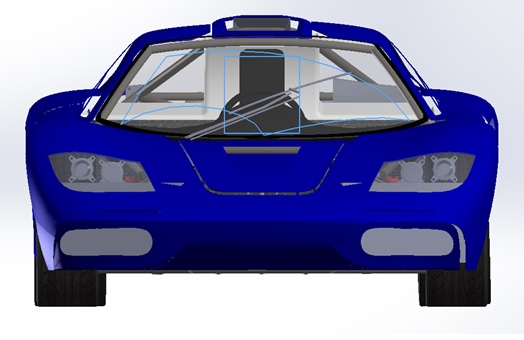540HP NA 7L V12 3 seater
Discussion
ivanhoew said:
Nice shape !
Thanks, I am still undecided if it is a shameless ripoff or respectful homage...if I can lay 50ft black lines on the road then I am leaning towards the latter.I am so impressed you have a dyno in your shed, very useful. I had never seen anyone find TDC with a whistle before either, you have lots of cool tricks up your sleeve. I am also using tunerstudio, but running the speeduino ECU. Over the last few months Josh has been putting out new videos detailing the circuits and programming, so will be doing a lot more electronics and wiring than welding over the next few months.
Today I am compiling the appendices for the 4B design submission to the LVVTA. I will be applying for the build approval in the next few weeks as everything except the windscreen wiper arm mechanism is fleshed out in enough detail now.
Suspension and frame loads are not specified by the NZ regulatory body, however I based my analysis around multiple sources;
1) Costin and Phipps appendix 1 (oldie but a goodie)
2) Load case table from the ULSAS project that Lotus published (the most up to date reference)
3) an old SCCNZ scrutineering document (lots of really practical old school tips littered throughout)
4) 3rd Edition Australian Design Rules for torsion and beaming (68kg per passenger seems an underestimate for average weight these days.....)
Load cases were;
Square on Curb Strike = 0.5g in X, 3g in Z - applied at tire contact patch (analysis of 2 cases - forward motion and front axle, rearward motion and rear axle)
Lateral Curb Strike = 1.5g in Y, 1g with weight transfer in Z - applied at wheel rim lower position - front and rear
Heavy Braking = 1.1g in X, 1g with weight transfer in Z - applied at tire contact patch
Severe Pot Hole = 1.5g in X, 4g in Z - applied at tire contact patch
Diagonal bump = 4g in Z - applied at tire contact patch (for those unexpected offroad excursions where velocity outpaces lateral grip)
6G at all shock mounts in direction of action at ride height
Static wheel loads are 338kg each at the front, 422kg each at the rear, in Gross Mass (GMV) condition. The forces the frame and suspension have been calculated to withstand are the acceleration values and directions above multiplied by the wheel loads (some are amplified by weight transfer also). These studies were conducted on the bare steel frame, which in reality will be stiffened and strengthened by composite panels, however I do not have the skills to study that more complex structure - so will measure the end result and compare to the bare frame design calcs to get the final signoff by the certifier.
ADR torsional compliance requires no permanent deflection after applying a torque = track x 0.25 GVM * g = in this case 6253Nm. The frame model deflected 0.53 degrees at this theoretical load, so expecting >12500Nm/degree final frame stiffness, which is fine for a road car with supple suspension.
Edited by F1natic on Sunday 23 August 10:14
curb weight is going to be 1300 to 1350 kg with driver and fuel (No aircon, no radio). I have not modelled every bolt so added provisional values for some systems, but all the big parts are accounted for. The total weight cannot exceed 1500kg or the donor corvette rear axle is overloaded (1870lbs according to General Motors) and i will not get certification signoff, so at target weight can carry a couple of passengers without issue.
The drivable test mule sans bodywork is 1100kg, which is based on CAD model sums. Traction will be tricky, but now that I have the ediff, things will get interesting on that front.
The drivable test mule sans bodywork is 1100kg, which is based on CAD model sums. Traction will be tricky, but now that I have the ediff, things will get interesting on that front.
Edited by F1natic on Monday 24th August 19:38
A big inspiration (and cautionary tale) for me as a young lad was the tale of the Giocattlo effort by Paul Halstead in the late '80s. I owned an Alfa sprint for a few years with the idea in the back of my head of making a lightweight version using a lexus V8, but the transaxle was always the issue. However today while browsing an article on the old cars I discovered his new adventure, and I thought I was a bit "eccentric" for going twin engined....
Apparently the Giocattolo “Marcella” is underway. It is a midengined 3 seater design, although it has a canopy entry system.
Long term the vibration on the cranks from the high power LS engines may cause gear reliability issues with this arrangement (same as it did for the LearAvia Lear Fan 2100), and is one of the main reasons I didn't use this configuration, although its common on tractor pull designs.
Its not my cup of tea, but I admire his budget!
To save you searching - https://www.go2hal.com/
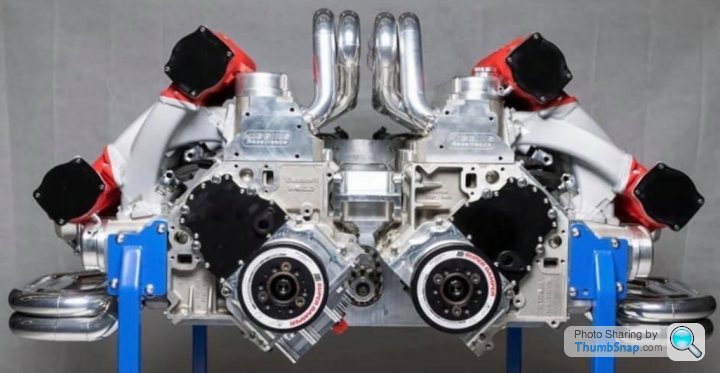
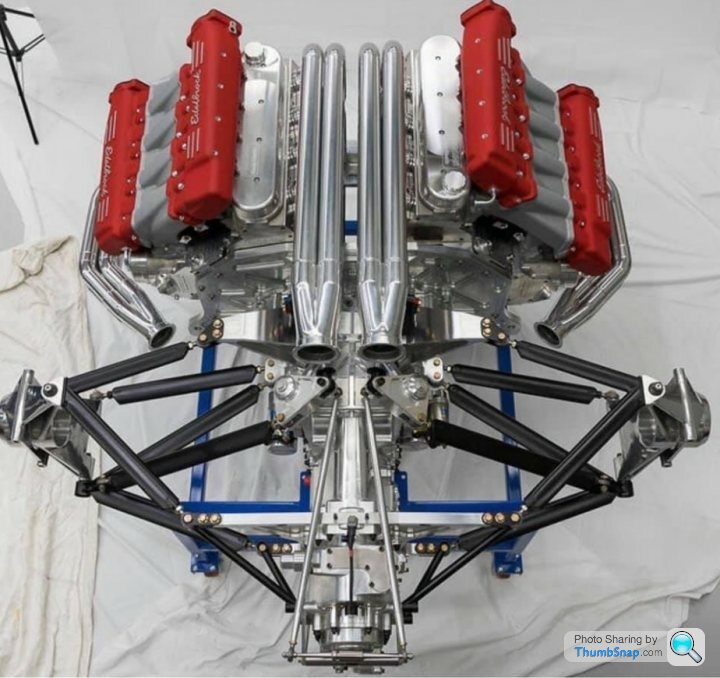
Apparently the Giocattolo “Marcella” is underway. It is a midengined 3 seater design, although it has a canopy entry system.
Long term the vibration on the cranks from the high power LS engines may cause gear reliability issues with this arrangement (same as it did for the LearAvia Lear Fan 2100), and is one of the main reasons I didn't use this configuration, although its common on tractor pull designs.
Its not my cup of tea, but I admire his budget!
To save you searching - https://www.go2hal.com/


Edited by F1natic on Saturday 29th August 08:50
Those things revved so hard and sounded really good, and the 2.5 put out 200hp, so x 2 would be good. Are they still available? For me it always comes back to $/hp - hence going for the bolt-on solution. I have seen a guy spend a literal fortune to put a 4 valve head on his rover v8. Just because you can doesn't mean you should (oh man I bet those words come back to haunt me in the future!)
Edited by F1natic on Saturday 29th August 09:31
Hinge axis proved quite time consuming to lock in, done now so can detail the complex lower hinge and door latch tomorrow.
Mucking around with render settings, result below. Brake calipers and throttle pedal are not shown because they are not modelled yet - same goes for the internals of the door.
The sill is high to increase spaceframe stiffness and side intrusion resistance.
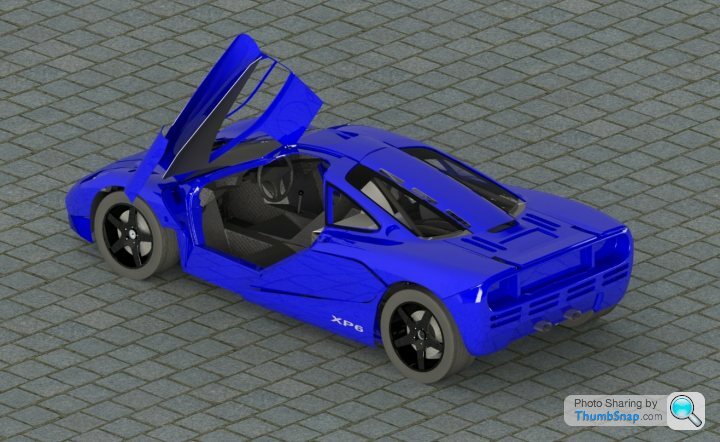
Mucking around with render settings, result below. Brake calipers and throttle pedal are not shown because they are not modelled yet - same goes for the internals of the door.
The sill is high to increase spaceframe stiffness and side intrusion resistance.

LaurasOtherHalf said:
My dream engine was a splice of two Mazda k series V6s, all aluminium construction which would get you a lovely little V12 with as little as 3.6l capacity.
It seems that some engineers in Hiroshima had the same dream as you, only for it to be rudely punctured when the bubble burst:https://jalopnik.com/it-was-japan-s-most-daring-ca...
The Amati, as Hall explained, having worked on the program, was a V12, using pieces sourced from Mazda’s existing (and weirdly overbuilt) V6 program. It used “rotating assemblies of the K series in a new block,” as Hall put it. “This was a completely new block,” he added, though “the valvetrain was the same.”
It made the requisite 280 HP, but, typical of Mazda engines, it was good on power if weak on torque, Hall said. “Faster in 60-80 passing speed,” compared to a Lexus LS400, “not as fast to 60.”
“They had done a 3.6 of the two 1.8s,” Hall said. “The block was designed up to a 5.0-liter. North America would be a 4.6 from two 2.3s.”
samoht said:
It seems that some engineers in Hiroshima had the same dream as you, only for it to be rudely punctured when the bubble burst:
https://jalopnik.com/it-was-japan-s-most-daring-ca...
Thank you for that link, it was a fascinating read. I had never heard about the Amati V12 or the M2 factory, very cool concept. Always loved the Autozam AZ-1, cool little car. https://jalopnik.com/it-was-japan-s-most-daring-ca...
Edited by F1natic on Saturday 29th August 22:56
F1natic said:
samoht said:
It seems that some engineers in Hiroshima had the same dream as you, only for it to be rudely punctured when the bubble burst:
https://jalopnik.com/it-was-japan-s-most-daring-ca...
Thank you for that link, it was a fascinating read. I had never heard about the Amati V12 or the M2 factory, very cool concept. Always loved the Autozam AZ-1, cool little car. https://jalopnik.com/it-was-japan-s-most-daring-ca...
Edited by F1natic on Saturday 29th August 22:56
Doing the prep work to decode the cam signal positions that will allow the ECU to find the true position of the test motor during cranking/running. The Hall sensor for the cam (CMP) is the round object in the cutout at the 9 o'clock position. Theory is that the ECU will read the cam signal whenever it detects the crank trigger ( a 2 tooth gap on the 60 tooth wheel bolted to the crankshaft - so occurs every 360 degrees). The cam signal will either be on or off depending on the true position of the motor set by the blocks on the back of the cam pulley shown. The ECU can't tell the difference between TDC on 5 or on 1, but its important if you want to run sequential fuel injection and ignition. The Speeduino is currently limited to 9 timer channels so I am going to use 6 for fuel injection and 3 for ignition. The fuel will be sequential, but the ignition will be batch fire (where the ECU fires 2 spark plugs at once, one of which will be a cylinder on its exhaust stroke)
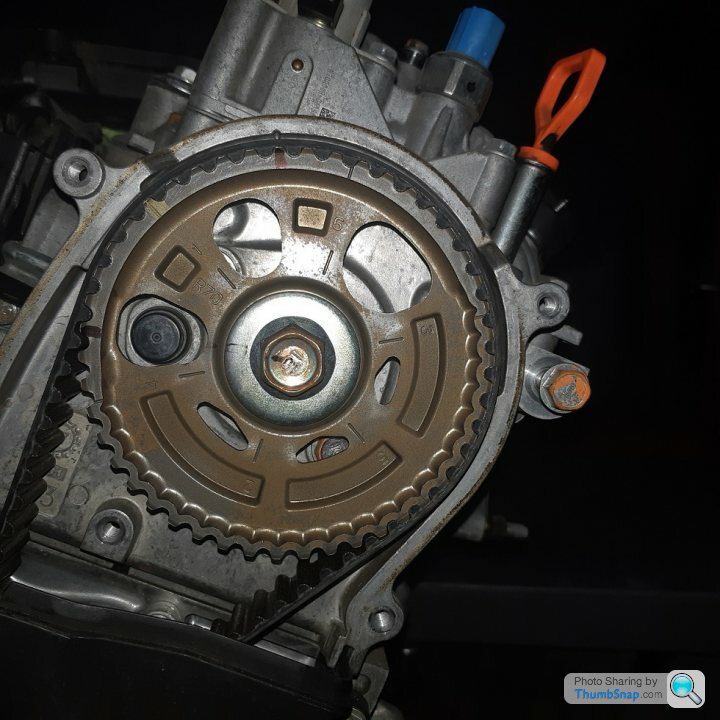

Turns out that C6 Z51 drive shafts fit the output splines of the TR6070 box, which is an unexpected bonus as I can put off upgrading the rear drive hubs to C7 units until I have put a few miles on the test mule. Unlike the C7 units the C6 driveshafts are equal size, which can contribute to diff destroying wheel hop.
After reading the IMechE paper by Steve Randle about the concept and design of the McLaren F1 suspension systems* I was hoping to achieve a steering ratio of 18:1. However reviewing the Titan datasheets for "off the shelf" pinions and racks has resulted in the closest ratio that works with the corvette front spindle steering arm length giving around 20.6:1 - which is the same ratio as the early Honda NSX.
I have read on the internet that the NSX initially feels like it steers too slow, but not having driven one I will trust Ayrton Senna, who had no issues hustling the NSX around Suzuka. Since most high speed driving is done with less than 5 degrees of road wheel deviation this results in 106 degrees of steering wheel rotation at the 20.6:1 ratio (or 2.55 turns lock to lock). By comparison the steering wheel angle with a very fast 17:1 ratio would be 90 degrees.
Given this will be an unassisted rack I am happy to start off with the higher ratio rack. Tire stiffness has a large effect on steering feel so lots of room for development**
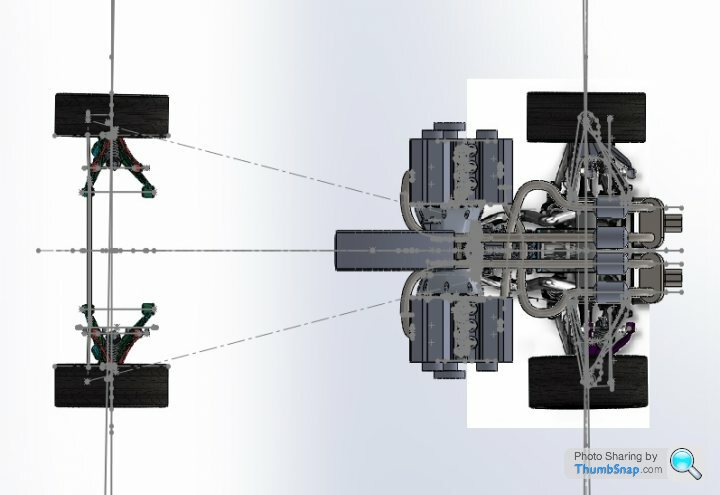
After reading the IMechE paper by Steve Randle about the concept and design of the McLaren F1 suspension systems* I was hoping to achieve a steering ratio of 18:1. However reviewing the Titan datasheets for "off the shelf" pinions and racks has resulted in the closest ratio that works with the corvette front spindle steering arm length giving around 20.6:1 - which is the same ratio as the early Honda NSX.
I have read on the internet that the NSX initially feels like it steers too slow, but not having driven one I will trust Ayrton Senna, who had no issues hustling the NSX around Suzuka. Since most high speed driving is done with less than 5 degrees of road wheel deviation this results in 106 degrees of steering wheel rotation at the 20.6:1 ratio (or 2.55 turns lock to lock). By comparison the steering wheel angle with a very fast 17:1 ratio would be 90 degrees.
Given this will be an unassisted rack I am happy to start off with the higher ratio rack. Tire stiffness has a large effect on steering feel so lots of room for development**

- - IMechE paper C466/007/93
- - the process of throwing money at problems until they go away
Edited by F1natic on Saturday 19th September 05:28
It’s been such a long time since I’ve driven one but I recall the slow steering on the mk1 NSX.
It might be worth asking Flemke in his thread as he owns both, I’m prettY certain though that I disagreed with him completely when it came down to NSX steering ratio.
As opposed to something like an exige with it’s quick rack, I always found the NSX to be too slow for its on the limit handling.
Before the deification of both the nsx and Senna, they were known as very tricky cars to drive and rather like the S2000, had a reputation for chucking people off on track days.
For reference, my bench mark for steering speed and feel was the old mk3 MR2 Spyder.
It might be worth asking Flemke in his thread as he owns both, I’m prettY certain though that I disagreed with him completely when it came down to NSX steering ratio.
As opposed to something like an exige with it’s quick rack, I always found the NSX to be too slow for its on the limit handling.
Before the deification of both the nsx and Senna, they were known as very tricky cars to drive and rather like the S2000, had a reputation for chucking people off on track days.
For reference, my bench mark for steering speed and feel was the old mk3 MR2 Spyder.
Thanks for the feedback, always appreciated. I took an MR-S for a test drive on my reference road* and to date it was the best car I had driven for front end response, although it is also lightweight, has small wheels and a short wheelbase.
Double checked the options from Titan and will go for the middle of the road ratio using the 8T 14 DP pinion in an eccentric rack, which gives a steering ratio of 17.5:1. Changing to the 9T 14DP will give 15.5:1 and 7T 14DP will give 20:1, so a good range of options for the future without huge expenditure, given the eccentric housing allows the pinions to be changed without too much hassle.
Early thinking was slower steering might be best for a manual steering setup in a 200mph capable car, to reduce the sneeze and crash effect, however given the car will be a daily driver and used in the legal speed range slow steering may not be as desirable. Having a faster rack may be of great value given the rear end will have a tendancy to step out with 688nm on tap.
Also was fortunate to experience a 350 mile dawn raid last weekend in a very capably driven 2018 Carrera T, with around 480hp. It recalibrated my brain as to the benchmark for handling I would like to achieve for tight and bumpy New Zealand back roads. With rear steering and power assit the ratio gets down to 12.5:1, but is 15.0:1 in centre position. It worked really well.
Double checked the options from Titan and will go for the middle of the road ratio using the 8T 14 DP pinion in an eccentric rack, which gives a steering ratio of 17.5:1. Changing to the 9T 14DP will give 15.5:1 and 7T 14DP will give 20:1, so a good range of options for the future without huge expenditure, given the eccentric housing allows the pinions to be changed without too much hassle.
Early thinking was slower steering might be best for a manual steering setup in a 200mph capable car, to reduce the sneeze and crash effect, however given the car will be a daily driver and used in the legal speed range slow steering may not be as desirable. Having a faster rack may be of great value given the rear end will have a tendancy to step out with 688nm on tap.
Also was fortunate to experience a 350 mile dawn raid last weekend in a very capably driven 2018 Carrera T, with around 480hp. It recalibrated my brain as to the benchmark for handling I would like to achieve for tight and bumpy New Zealand back roads. With rear steering and power assit the ratio gets down to 12.5:1, but is 15.0:1 in centre position. It worked really well.
- - the one outside my house
I'm not sure on the specs, but after the MR2 the next best was a generation 996/997 Porsche GT3 although I'll caveat that they need a smaller steering while fitted (such as the cup one), the standard is just fractionally too big in diameter-not by much but enough.
One more to look at was the M3csl, it had (at he time) a hyper steering rack fitted (google says 14.5:1) and was blessed with a ridiculously thick steering rim.
Not sure if the CSL had different rear geometry to calm things down or it was just the long wheelbase but it managed the quick rack very well for what was an ordinary saloon car.
One more to look at was the M3csl, it had (at he time) a hyper steering rack fitted (google says 14.5:1) and was blessed with a ridiculously thick steering rim.
Not sure if the CSL had different rear geometry to calm things down or it was just the long wheelbase but it managed the quick rack very well for what was an ordinary saloon car.
Since the Auckland harbour bridge was damaged and commuting has been a chore I took the scenic way to work this morning. Lots of quiet country roads to allow recording of the ignition advance curve for the stock Honda ECU at 100% throttle, up some reasonable inclines to give a decent resistive load and thus a longer sampling window, using an OBD2 scanner/logger. It seems the ECU reverts to these values once more than 25% throttle is used. Interesting to see the effect of the VTEC on the advance required.
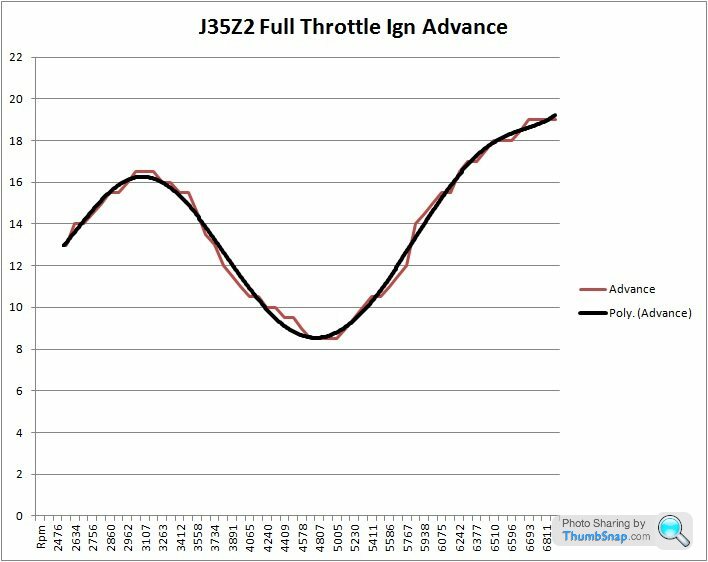

Gassing Station | Readers' Cars | Top of Page | What's New | My Stuff





